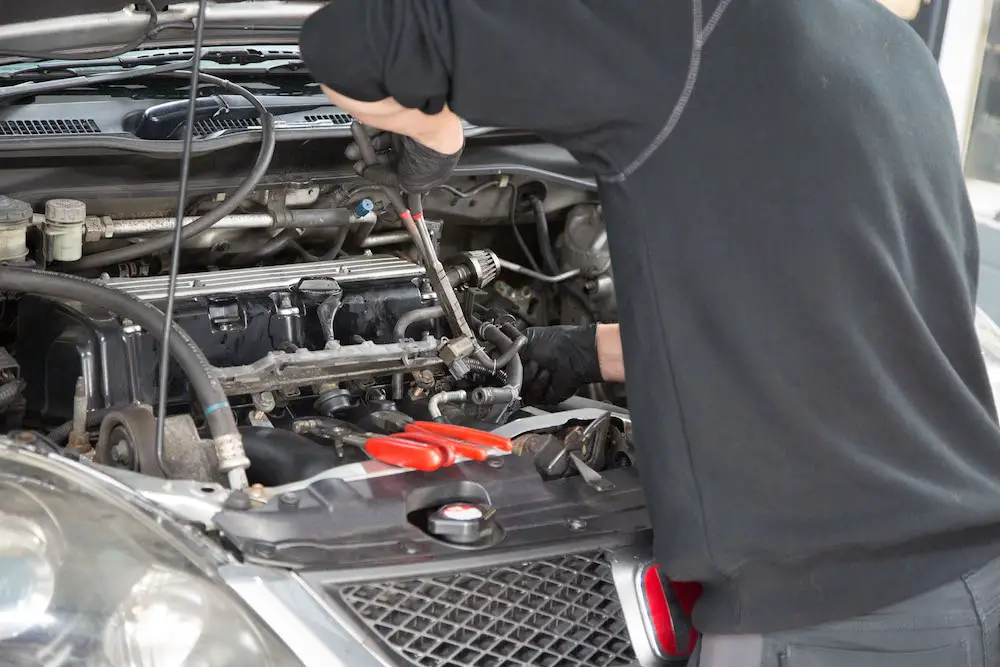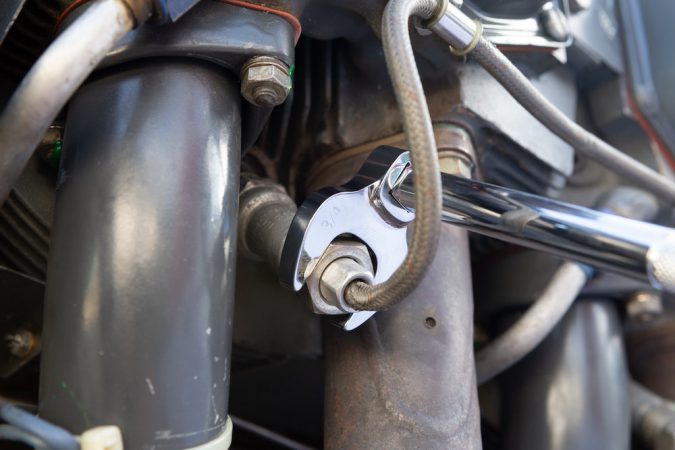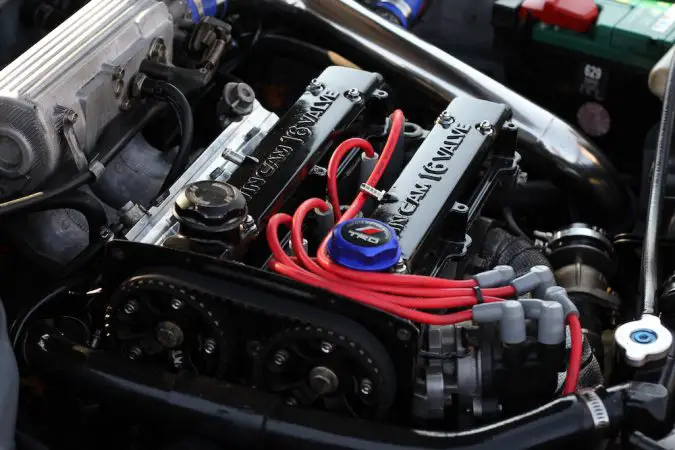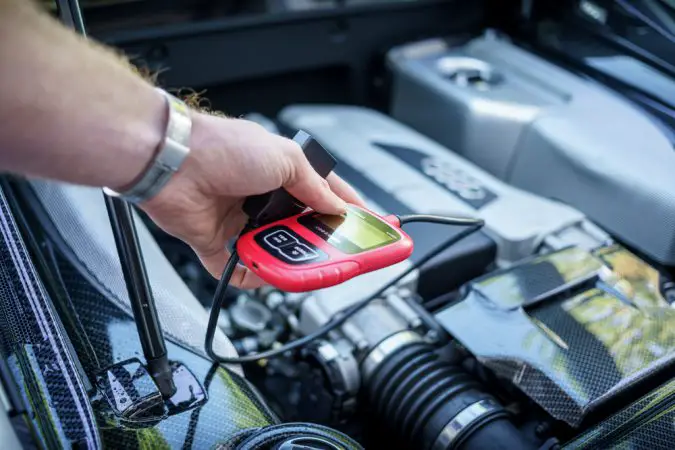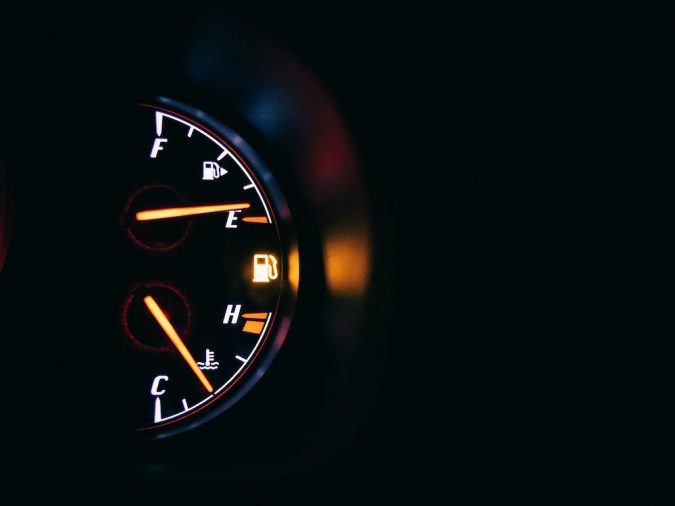Just as how the human body needs food, your car also derives its power from a source of energy. For those vehicles with internal combustion engines, that power comes from old, decomposed, and very-much-dead animals or plants buried deep underground. In short, fossil fuels, be it gasoline or diesel. However, that fuel might otherwise be useless, if you’re experiencing bad fuel injector symptoms.
Fuel injectors, as their name might aptly imply, are devices that inject fuel into the engine. They must ensure that the right amount of fuel is supplied to the engine, and at the right moment. In doing so, it could ensure smooth, reliable, and ample performance anytime you press down on the throttle. Yet, and no matter how crucial fuel injectors are for an engine, they are susceptible to wear and failure.
If and when they do fail, the bad fuel injector symptoms should be immediately apparent. You’ll soon start to notice a significant drop in performance. Not to mention a distinct roughness and unrefined nature to how your car now drives. On top of that, you can feel misfires, odd behavior, and a fairly big dent in your MPG. So, here’s a round-up on the most common bad fuel injector symptoms…
What Is A Fuel Injector, Anyway?
Before we get into bad fuel injector symptoms, it might be worthwhile to provide some context as to what this particular component does. So, what is a fuel injector, and how does it work? Well, and as we explained earlier, the fuel injector is a device that injects a precise amount of fuel into the engine, and at the right time. Remember that the mixture of fuel and air is crucial in an engine’s operation.
You can imagine fuel injectors like syringes, applying a set dosage of gasoline or diesel into your car’s engine. By injecting too much fuel, much of it will most likely go unburnt and is thus wasted. On the other hand, too little fuel being injected will leave your car handicapped for power. In addition to the amount of fuel, the fuel injectors need to also ensure that they time their injection properly.
For optimal performance, the ratio and mixture of air and fuel being fed to the engine must be ideal. Ultimately, this wouldn’t just affect the drivability of your car. On top of that, well-tuned and working fuel injectors can improve fuel efficiency, reliability of your engine, as well as tailpipe emissions. Fuel injectors, in design and construction, are nothing more than valves that open and close rapidly.
How rapidly, you might ask? Depending on your car and the engine it uses, fuel injectors might open and close many times a second. You could always find the injectors mounted on the intake manifolds. There, and as the injectors spray fuel into the manifold, it gets mixed in with air rushing through into the engine. This mixture of air and fuel enters the engine, is compressed, and subsequently ignited.
How Does The Fuel Injector Work?
- As you press down on the throttle pedal, your input is sent to the car’s central computer brain. This is most commonly referred to as the ‘engine control unit‘, or ECU.
- The ECU will calculate how much fuel to inject into the engine, based on the state of the gas pedal. Press the accelerator pedal down harder, and the ECU understands that it needs to pump a lot more fuel into the engine.
- At the same time, the ECU will analyze and measure the rate of air entering the engine. Additionally, it’ll calculate the engine’s current speed, the status of all the other moving components, oxygen volume in the exhaust, and more. It’s able to “read” this through a myriad of sensors dotted across your car.
- Your car’s ECU will now determine the right amount of fuel to inject, to get the air-to-fuel ratio just right. In most cars, they follow the stoichiometric ratio of 14.7:1. This means that for every 1 gram of fuel, 14.7 grams of air are required to reach an ideal mixture.
- Meanwhile, fuel is flown to the engine from your fuel tank. Subsequently, it’s being pressurized by the fuel pump, before passing it off to the fuel injectors.
- With all the right conditions in place, an electromagnetic solenoid in the fuel injectors moves a plunger, opening the valves. This enables the pressurized fuel to spray from the nozzle, and into the intake manifold.
- This nozzle is designed for atomization. In other words, making sure that the fuel isn’t merely flushed into the intake manifold. Rather, it’s distributed into a very fine mist, which can burn more easily.
- Finally, the fine mist of gasoline or diesel is thoroughly mixed in with the air surging through from the intake valves, before entering the engine.
What Are The Bad Fuel Injector Symptoms?
Diesel engines have been using fuel injectors since the early 30s. Meanwhile, gasoline engines made the switch from carburetors to injectors in the 50s. When the 90s came and went, injectors were prevalent in almost every car. This is owing to the growing demand to further improve fuel economy, while also combatting ever-increasing emissions. Yet, even today, they’re still vulnerable to failure.
To be fair, it’s quite rare for most to suffer fuel injector failure. That said, there may be circumstances where your fuel injectors might get clogged up by dirty fuel. Or, given enough time, use, and abuse, it might break down and fail altogether. When this happens, you’ll start to experience a few of the bad fuel injector symptoms. So, here’s what you may encounter if you have faulty, or failed injectors…
1. Engine Misfires – One Or More Cylinders Isn’t Firing
Should your fuel injector get too dirty, is clogged up, or has failed completely, it essentially denotes a disruption of fuel supply to the engine. The injectors might not supply fuel to the engine at all. Or, it’ll spray fuel in an untimely, inefficient, or unreliable manner, causing your engine to starve of fuel.
Naturally, your vehicle would start to drive poorly, and this is immediately noticeable. Among those bad fuel injector symptoms would be constant misfiring in the engine. Without enough fuel or even any amount of it in there, your car’s engine can’t function optimally.
Misfires are occasions where one or several of the cylinders in the engine aren’t firing or combusting in unison. For example, let’s say you have an inline-6. Out of the 6 cylinders in the engine, a misfire might see two of them get knocked out of commission. Thus, you’re now running on just 4 cylinders.
There are several ways to tell if you have a misfire:
- Your car feels sluggish, or as if it’s lacking power, especially while accelerating.
- Your engine idles roughly, with much more apparent vibrations, jerkiness, and shaking.
- The engine sounds different, as you’re only running on some of the cylinders, not all of them. It might sound more gruff and unrefined.
- There are backfiring and popping noises coming from the exhaust. This is due to unburnt fuel exiting the tailpipes.
- The engine may or may not start properly, or would have significant difficulty while cranking.
- You might experience stalling while driving, or the engine power cutting in and out.
- There’s a lot more exhaust smoke than usual, and you might see there’s a distinct coloration to the smoke. Usually, the smoke will appear as thick black plumes.
- The check engine light will appear, warning you that something’s amiss.
1.1. How To Diagnose Misfiring Due To Bad Fuel Injectors?
For better or worse, engine misfiring can be caused by any number of poor components, not just bad fuel injector symptoms. To better narrow down the exact cause, and see if faulty injectors truly are the cause behind your engine misfiring, there are some diagnosis steps that you can undertake.
Test #1 involves using a simple flathead screwdriver:
- Locate the fuel injectors, usually mounted on the intake manifold of your engine.
- With your flathead screwdriver in hand, place the metal tip of the screwdriver on top of one of the injectors.
- Now, place the plastic handle of the screwdriver to your ear.
- With the engine running, see if you can hear a rhythmic clicking sound running through the length of the screwdriver.
- These clicks mean that the fuel injectors are opening and closing properly.
- Now, repeat this test with all of the fuel injectors.
- If you can’t hear the clicking with one or more injectors, it’s a sure sign that it has failed.
Test #2 could be a great follow-up to the first test:
- Note down all of the failed fuel injectors that you’ve diagnosed earlier, the ones without any clicking sound to them.
- Next, grab your toolkit, and remove one of the bad fuel injector(s).
- Then, in its place, swap the bad injector with one of the good ones, those with audible clicks while the engine was running.
- If you hear clicks this time around, then you’ve confirmed that the bad injector has indeed failed.
But before you write off the bad injectors, you should proceed with a test of their electrical connectors. First, unplug the injector’s connectors, and use a multimeter to test its voltage. You can then refer to your car’s service manual for a detailed voltage specification for the injectors.
2. Rough Idling – Engine Feels And Sounds Rougher While Idling
Once again, this bad fuel injector symptom is related to the supply of fuel. As your injector fails or has been clogged up, it either can’t deliver fuel to the engine. Alternatively, it might spray the fuel at the wrong time, or do so in uneven amounts. Regardless, there isn’t an ideal circulation of fuel.
When you’re idling, you may be able to notice the engine running very roughly. This is because during idle, the RPM drops below an optimal level for the fuel injectors to be working at their best. Typically, this isn’t an issue with properly functioning fuel injectors, as they can operate on a wide RPM band.
While it’s idling, however, your engine speed (RPM, or revolutions per minute) drops to somewhere between 600 to 1,000RPM. At these low RPMs, bad fuel injectors will struggle to supply your engine with fuel. As such, you’ll begin to feel the engine, at idle, shaking, or vibrating more than usual.
In addition, other observations during a rough idle include seeing your RPMs fluctuating rapidly. And, the sound, while the engine is idling, would be more noticeable. If your fuel injectors are in even worse shape than anticipated, the engine might also stall while your car is idling.
3. Vibrations – Engine Shaking, Shuddering, And Knocking
This echoes our previous point of insufficient fuel reaching the engine due to clogged or bad injectors. Without enough fuel, one, some, or all of the cylinders can’t fire optimally. Once the engine can complete a full combustion cycle, it’ll vibrate, shake, shudder, and quiver.
You’ll be able to feel this quite readily, as your car feels and runs much more uncomfortably than it did before. You may also begin to hear distinct knocking sounds emanating from the engine, too. This is an especially important bad fuel injector symptom to notice if you’re driving a turbocharged car.
Turbocharged engines typically run hotter and harder than their naturally-aspirated counterparts. At higher RPMs, turbocharged engines require a lot more fuel to operate. Without enough fuel, or if the turbo engine gets too hot, the engine can quite literally detonate, causing vibrations.
4. Engine Power Surges – RPMs Continually Fluctuate
In stark contrast to there not being enough fuel in the engine, bad fuel injectors might also induce an opposite effect. In other words, the failing or faulty injectors might instead spray too much fuel into the engine. Similarly, this isn’t ideal, as there’s more fuel than the engine ideally needs.
With the injectors spraying an excessive amount of fuel into the engine, you might be able to feel its surge in power. The term ‘surge’ can be described as your engine not being able to burn or ignite the excess gasoline or diesel. One consequence of this is a loss of power and sluggish acceleration.
Furthermore, surges will affect the RPMs. With constant loads, such as cruising along on the highway, your RPM should be similarly constant, hovering at a set RPM. But as the fuel injectors are causing a surge, the RPM will bounce around a lot. That’s even with a constant force being applied.
5. Check Engine Light – Illuminating Your Dashboard
Another pretty tell-tale sign that something’s wrong with your vehicle, is the appearance of the check engine light (CEL) on the dashboard. Modern cars have an abundance of sensors to not only optimize the functionality of certain components. Moreover, they could analyze their condition.
As your fuel injectors are failing, the engine’s efficiency, performance, and operation will suffer. This can easily trip up and trigger the many sensors that monitor the engine’s array of components. Once the sensors detect that there’s an issue, this error data will be collected by the ECU.
Should your vehicle not be running in its most ideal state, the ECU will then prompt the check engine light to appear on your dashboard. It’s an alert to notify you to get your car checked out and have a peek at what’s wrong. Unfortunately, it can’t point you precisely towards the problem.
A single static, blinking, or flashing warning light can’t cover the many faults that could appear. The check engine light would even illuminate when simple problems are detected. For instance, your gas cap is not being tightened properly.
Thankfully, the ECU does store a whole heap of error codes in its memory. As it lights up, these error codes will be saved, which you can then read to understand more about why it appeared in the first place. You’re able to extract and view these error codes with an OBD diagnostics tool.
You could then browse online with these codes, and understand more of why it’s happening. Some of the OBD trouble codes that might appear with faulty fuel injectors include:
5.1. Bad Fuel Injector OBD Error Codes
- P0200 – Injector Circuit Malfunction
- P0201 – Injector Circuit Malfunction – Cylinder 1
- P0202 – Injector Circuit Malfunction – Cylinder 2
- P0203 – Injector Circuit Malfunction – Cylinder 3
- P0204 – Injector Circuit Malfunction – Cylinder 4
- P0205 – Injector Circuit Malfunction – Cylinder 5
- P0206 – Injector Circuit Malfunction – Cylinder 6
- P0207 – Injector Circuit Malfunction – Cylinder 7
- P0208 – Injector Circuit Malfunction – Cylinder 8
- P0209 – Injector Circuit Malfunction – Cylinder 9
- P0210 – Injector Circuit Malfunction – Cylinder 10
- P0211 – Injector Circuit Malfunction – Cylinder 11
- P0212 – Injector Circuit Malfunction – Cylinder 12
- P0213 – Cold Start Injector 1 Malfunction
- P0214 – Cold Start Injector 2 Malfunction
- P0611 – Fuel Injector Control Module Performance
- P0612 – Fuel Injector Control Module Relay Control Circuit
- P1200 – Injector Control Circuit
- P1201 – Injector Circuit Open/Shorted – Cylinder 1
- P1202 – Injector Circuit Open/Shorted – Cylinder 2
- P1203 – Injector Circuit Open/Shorted – Cylinder 3
- P1204 – Injector Circuit Open/Shorted – Cylinder 4
- P1205 – Injector Circuit Open/Shorted – Cylinder 5
- P1206 – Injector Circuit Open/Shorted – Cylinder 6
- P1209 – Injector Control Pressure System Fault
- P1210 – Injector Control Pressure Above Expected Level
- P1211 – Injector Control Pressure Sensor Above/Below Desired
- P1212 – Injector Control Pressure Not Detected During Crank
- P1213 – Start Injector Circuit Malfunction
5.2. Bad Fuel Injector OBD Error Codes (Diesel Only)
- P0251 – Injection Pump Fuel Metering Control A Malfunction (Cam/Rotor/Injector)
- P0252 – Injection Pump Fuel Metering Control A Range/Performance (Cam/Rotor/Injector)
- P0253 – Injection Pump Fuel Metering Control A Low (Cam/Rotor/Injector)
- P0254 – Injection Pump Fuel Metering Control A High (Cam/Rotor/Injector)
- P0255 – Injection Pump Fuel Metering Control A Intermittent (Cam/Rotor/Injector)
- P0256 – Injection Pump Fuel Metering Control B Malfunction (Cam/Rotor/Injector)
- P0257 – Injection Pump Fuel Metering Control B Low (Cam/Rotor/Injector)
- P0258 – Injection Pump Fuel Metering Control B Low (Cam/Rotor/Injector)
- P0259 – Injection Pump Fuel Metering Control B High (Cam/Rotor/Injector)
- P0260 – Injection Pump Fuel Metering Control B Intermittent (Cam/Rotor/Injector)
5.3. Bad Fuel Injector OBD Error Codes (Cylinder-Specific)
- P0261 – Cylinder 1 Injector Circuit Low
- P0262 – Cylinder 1 Injector Circuit High
- P0264 – Cylinder 2 Injector Circuit Low
- P0265 – Cylinder 2 Injector Circuit High
- P0267 – Cylinder 3 Injector Circuit Low
- P0268 – Cylinder 3 Injector Circuit High
- P0270 – Cylinder 4 Injector Circuit Low
- P0271 – Cylinder 4 Injector Circuit High
- P0273 – Cylinder 5 Injector Circuit Low
- P0274 – Cylinder 5 Injector Circuit High
- P0276 – Cylinder 6 Injector Circuit Low
- P0277 – Cylinder 6 Injector Circuit High
- P0279 – Cylinder 7 Injector Circuit Low
- P0280 – Cylinder 7 Injector Circuit High
- P0282 – Cylinder 8 Injector Circuit Low
- P0283 – Cylinder 8 Injector Circuit High
- P0285 – Cylinder 9 Injector Circuit Low
- P0286 – Cylinder 9 Injector Circuit High
- P0288 – Cylinder 10 Injector Circuit Low
- P0289 – Cylinder 10 Injector Circuit High
- P0291 – Cylinder 11 Injector Circuit Low
- P0292 – Cylinder 11 Injector Circuit High
- P0294 – Cylinder 12 Injector Circuit Low
- P0295 – Cylinder 12 Injector Circuit High
6. Fuel Leakage – Noticeable Leaking, Or Scent
If your fuel injectors are a bit on the old side, they might start breaking or cracking. Often, the key point of failure is likely the injector seals rather than the housing. Either way, fuel might start to leak out of the injectors. This isn’t just wasteful and detrimental to performance, but it’s also a serious hazard.
Usually, you can spot traces of gasoline or diesel leaking out onto the fuel rail. Or, perhaps even drips of it might be noticed on the intake manifold itself. If you happen to not see any visible leakage, you might be able to smell it. Gasoline and diesel have a strong smell, so trace where it’s coming from.
The scent may not necessarily come from the engine bay, mind you. If there’s unburnt fuel due to a bad fuel injector, raw gas or diesel will exit the tailpipes. You may be able to smell fuel there, too. It’s essential to have this fixed promptly, or otherwise, your car could catch on fire.
7. Poor Fuel Economy – MPGs Are (Much) Lower Than Usual
With bad fuel injectors, the sporadic circulation of fuel into your engine will naturally leave a mark on your MPG figures. There’s one of two possibilities here:
- The bad fuel injector(s) are spraying excessive amounts of fuel into the engine, which increases your fuel consumption.
- Or, the bad fuel injector(s) aren’t spraying enough fuel into the engine. Thus, forcing the ECU to ask the other, healthy injectors to spray a lot more fuel to compensate.
With far more fuel being pumped into the engine, you’ll start to notice your MPG tanking. Granted, and depending on how bad the fuel injectors are, it might take some time for you to spot this. Based on how bad the injectors are, the impact on your MPG may or may not be significant.
8. Failed Emissions Test – Unburnt Fuel Out Of The Tailpipes
With bad fuel injectors, one of the consequences would of course be incomplete combustion. Or to put it another way, fuel is not being burned thoroughly. This is the case if the injectors are pumping a lot of fuel into the engine, more so that it could handle and ignite at a time.
The only place for the unburnt fuel to go is out of the tailpipe. Unburnt fuel will lead to a substantial spike in your carbon emissions, as you’re essentially exhausting liquid fuel. Therefore, if you were to take your car out for its regular emissions testing, it may immediately fail.
There may also be circumstances where the fuel injectors would leak constantly into the engine. As a result, your air-to-fuel mixture will turn incredibly rich (too much fuel, too little air). So rich in mixture, in fact, it could possibly be hot and toxic enough to burn out your catalytic converters.
Facts about Dirty Fuel Injectors and Their Symptoms
- Dirty fuel injectors can cause poor vehicle performance, lousy gas mileage, and rough idling.
- Fuel injectors, along with the fuel filter and pump, ensure the correct fuel and air mixture in the engine.
- The fuel injector sprays fuel into the intake manifold at a precise angle, where it mixes with air before being compressed in the combustion chamber to power the engine.
- Signs of dirty fuel injectors include engine misfires, rough idling, decreased gas mileage, unpredictable RPM needle movement, and engine failure.
- Dirty fuel injectors can cause engine misfires, where the motor feels like it is sputtering, due to an imbalance in the fuel and air mixture.
- Rough idling is characterized by varying RPMs when the vehicle is stationary, and it is usually accompanied by engine stalling, which feels like running out of gas on a hill.
- Poor gas mileage could be a sign of dirty fuel injectors.
- Dirty fuel injectors can cause the RPM needle on the tachometer to move unpredictably.
- In some rare cases, dirty fuel injectors can lead to engine failure that prevents the car from starting.
- For engine problems, including dirty fuel injectors, it’s recommended to get a complete vehicle inspection by an expert technician to diagnose and recommend solutions.
Final Thoughts On Bad Fuel Injector Symptoms
Well then, that just about sums up all of the most common bad fuel injector symptoms. It’s vital that you take prompt action as soon as they appear. Driving with bad fuel injectors is a terrible idea. Not only is your car unpleasant to drive. However, the faulty injectors may accelerate wear and damage to other parts of your car, as well. Most noticeably the fuelling system, engine, and exhausts.
If you’re wondering about what to do now, you have several options for a fix:
- Cleaning – Following a detailed diagnosis, let’s say the injectors haven’t failed, but are merely dirty or have clogged up. You can purchase fuel injector cleaning kits online, and unclog them yourself. Or, a local workshop could perform a deep cleaning of your injectors for around $50 to $100. In some cases, you’re able to ship them over to your car manufacturer, who will clean them for around $10 to $20.
- Replacement – If the fuel injectors are terribly damaged or worn out, they need to be replaced. It’s a good idea to do this every 100,000 miles or so. It’s not cheap, though. On average, you can expect a replacement cost of around $100 to $500. For more complicated cars, it may even cost you closer to $1,000. In some cases, it might still exceed that and could cost upwards of $2,000.
As they say, preventing maintenance is your best bet at ensuring healthy, long-lasting, and reliable fuel injectors. One of the best tricks for maintaining fuel injectors is grabbing a bottle of fuel injector cleaner. It’ll only cost you around $10 to $20. And, you really only need to empty a bottle into your gas tank every so often. This alone could prevent bad fuel injector symptoms from ever appearing.

